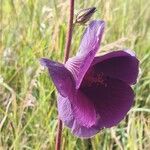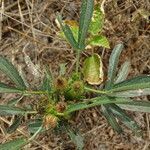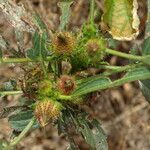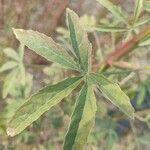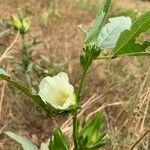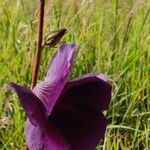A herb. It can grow from seed each year or keep growing from year to year. It grows up to 3.5 m high. It has a few sharp spines. The leaf stalk is 6-20 cm long. The leaf blade has 2 forms. The leaves lower on the stem are heart shaped and those higher on the stem have 4-7 lobes arranged like fingers on a hand. These lobes are sword shaped and 2-12 cm long by 0.6-2 cm wide. They have teeth around the edge. They taper at the tip. The flowers are yellow, white or ivory and red at the base. They occur singly in the axils of leaves. They are large and up to 10 cm across. They have very short stalks. The fruit is a capsule about 1.5 cm across. The seeds are kidney shaped.
Leaf-lamina up to c. 15 × 15 cm., usually suborbicular in outline, scaberulous or almost glabrous with a few minute prickles on the nerves, 3–7-palmatisect to palmate-lobed, often somewhat pedate (usually nearly entire in seedlings and sometimes near the apex of the stems), apex acute, margin serrate or dentate, rarely subentire, base broadly cuneate to shallowly cordate, usually with a prominent gland on the under surface near the base of the midrib, lobes elliptic to entire; petiole up to 22 cm. long, hairy like the stems; stipules 4·5 mm. long, narrowly linear to filiform, very caducous (rarely seen on dried specimens).
Calyx up to 20·5 cm. long, 10-nerved, setose; lobes long, acuminate (sometimes subcaudate), joined for up to 5 mm. at the base, aculeate or setose outside especially near the margin, margin sometimes with a woolly tomentum, usually with a prominent gland 1·5–2 mm. in diam. on the midrib.
Annual herb, up to 2 m high. Stems aculeate. Leaves suborbicular in outline, 3-7-palmatisect or palmately lobed. Calyx lobes acuminate or long-acuminate; gland on calyx lobe conspicuous. Flowers pale yellow, whitish or greyish with purple centre.
Annual herb up to c. 2 m. tall; stems aculeate with small rather sparse prickles usually pointing upwards, otherwise nearly glabrous or with a longitudinal line of crisped pubescence changing its radial position at each node.
Flowers up to 10 cm. in diam., usually pale yellow, whitish or greyish, with purple centre, solitary, axillary or in racemes by the reduction of the upper leaves; peduncle 2–6 mm. long, aculeate or setose.
Epicalyx of 7–8 bracts, bracts up to 18 mm. long, linear, joined for about 2 mm. at the base.
Seeds 3–3·5 × 1·5–2·5 mm., irregularly subreniform, minutely faveolate.
Staminal tube up to 23 mm. long; free parts of filaments 1–2 mm. long.
Petals up to 6 × 4·5 cm., obovate, pubescent outside, glabrous within.
Capsule up to 20 × 15 mm., ovoid-acuminate, appressed-setose.
Flowers large, yellow with a red-purple centre
Cultivated as a fibre plant, and naturalized.
An erect annual, to 15 ft. high
Style-branches 2–3·5 mm. long.
